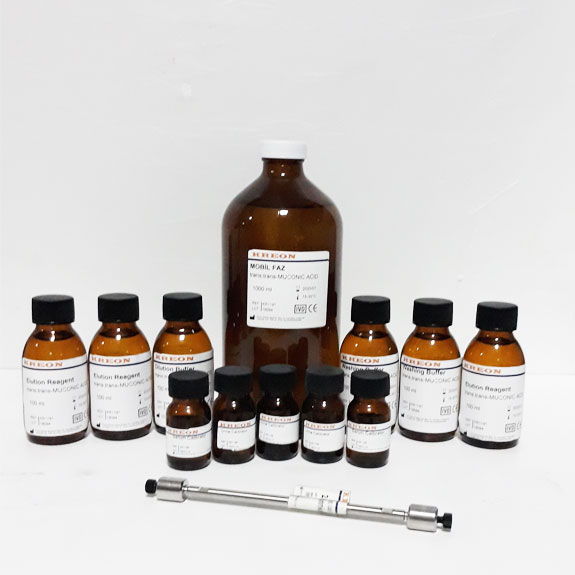trans, trans -MUCONIC ACID (Urine) HPLC
trans, trans-MUCONIC ACID For HPLC
INTENDED USE
KR148 Reagent kit for the HPLC determination of trans, trans-Muconıc Acıd in urine.
KIT SPECIFICATION
Contents for 100 analyses
|
Cat no
|
Quantity
|
Reagents
|
|
KR1481
|
1000 mlx1
|
Mobile Phase
|
|
KR1482
|
15 mlx1
|
İnternal Standart
|
|
KR1483
|
0.5 mlx5
|
Urine Calibrator
|
|
KR1484
|
100 mlx1
|
Dilution Buffer
|
|
KR1485
|
100 mlx3
|
Washing Buffer
|
|
KR1486
|
100 mlx3
|
Elution Reagent
|
ACCESSORIES
|
KR1487
|
1 adet
|
HPLC column for the analysis of trans, trans-Muconıc Acıd in urine.
|
|
KR1488
|
100 adet
|
Autosampler vial with teflon caps
|
CONTROLS
|
KR1489
|
0.5 ml x5
|
Urine Control, Level I
|
|
KR1490
|
0.5 ml x5
|
Urine Control, Level II
|
INTRODUCTION
The measuring of trans,trans-MUCONIC Acid is advised as a biological and reliable marker for observing workers subject to benzene.
Benzene is an industrial chemical product that often appears in mineral oils following combustion processes. Because of this reason, there is a high risk of environmental pollution . Its levels in the air can easily remain due to emissions from coal and oil burning, benzene leak and storage operations, exhaust fumes from cars, evaporation from gasoline service stations, and use of industrial solvents. Benzene may be produced by smoking in air since tobacco includes high level of benzene.
Breathing benzene for long periods may have different harmful effects. In fact, it is haematoxic and has been defined as a carcinogen, can bring to anaemia, excessive bleeding and it can have harm for the immune system and the reproductive organs.
Benzene is primarily metabolised by a cythocrome P-450 ( CYP-450 ) to phenolic compounds. The range of metabolic conversion of benzene to t,t-MA is about 2 – 25 % and dependent on the benzene exposure level.
EQUIPMENT AND INSTRUMENTAL PARAMETERS
The analysis of trans,trans-MUCONIC ACID requires a HPLC system including isocratic pump, autosampler and UV detector.
The use of a solvent degasser prevents air bubbles and ensure a stable baseline.
Sampler: Injection volume 50 μl, analytical run time 10 min..
HPLC pump: Flow rate 1.0 ml/min is recommended
Column temperature: Ambient (~25 °C)
UV detector: 264 nm
COLLECTION AND STORAGE OF PATIENT SAMPLES
The sample material is 24 hours urine. Storage life at room temperature is about 1 day, refrigerated (+2 to +8 °C) up to 1 week and frozen below -20 °C up to 6 months.
SAMPLE PREPARATION PROCEDURE
1 ml urine, 150 µl Internal standart, 1 ml Dilution Buffer
Transfer the whole sample to a conditioned sample preparation column
Wash with 2ml Washing Buffer
Elute with1ml Elution Reagent
Inject 50 µl
Samples prepared as above can be stored at ambient temperature for about 24 hours, at +2 to +8 °C up to 36 h, frozen below -18 °C up to 3 months.



